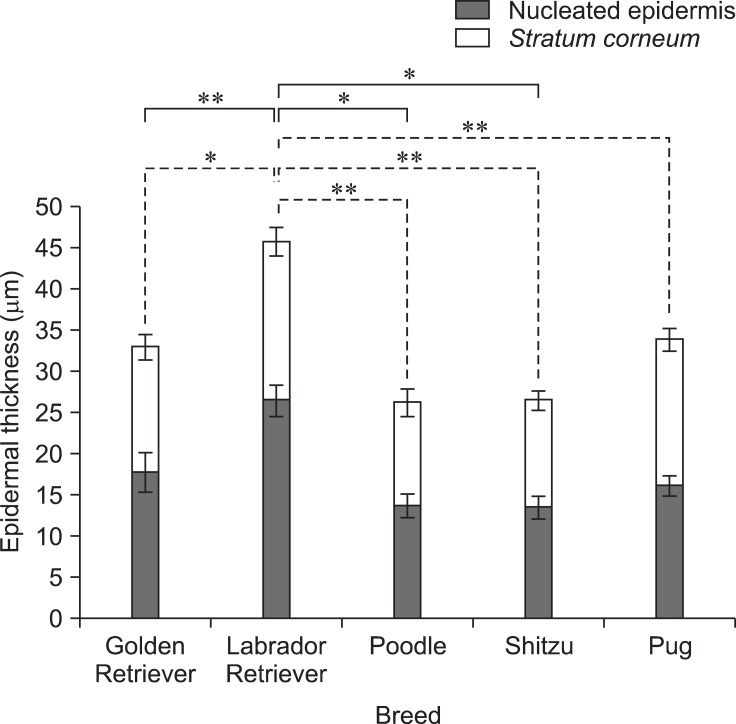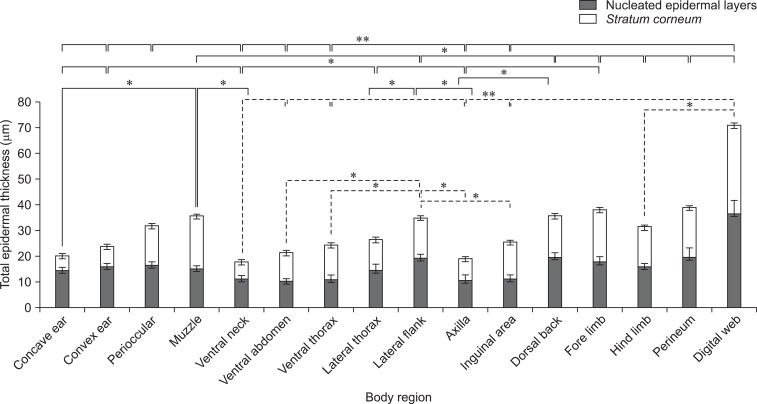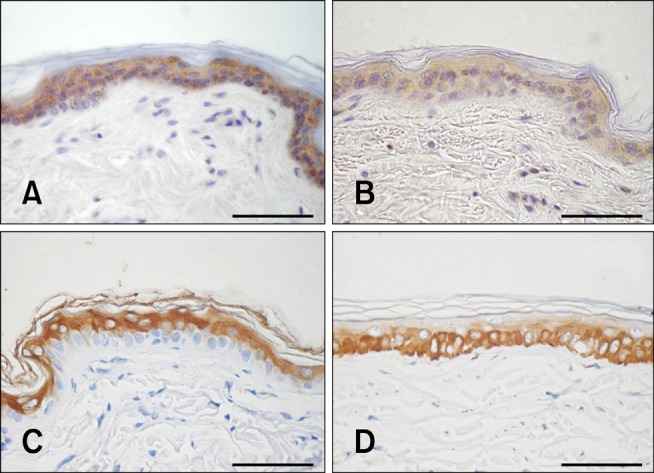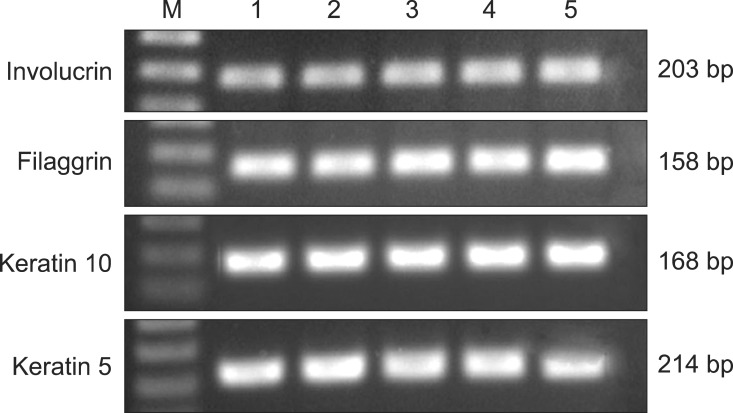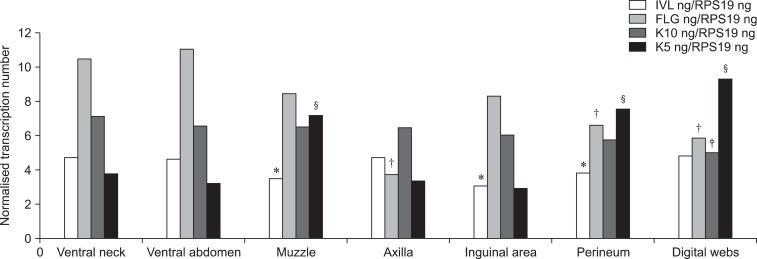J Vet Sci.
2012 Jun;13(2):163-170. 10.4142/jvs.2012.13.2.163.
Histologic morphology and involucrin, filaggrin, and keratin expression in normal canine skin from dogs of different breeds and coat types
- Affiliations
-
- 1Department of Veterinary Pathology, Faculty of Veterinary Science, Chulalongkorn University, Bangkok 10330, Thailand. achariya.sa@chula.ac.th
- 2Department of Physiology, Faculty of Veterinary Science, Chulalongkorn University, Bangkok 10330, Thailand.
- KMID: 1376190
- DOI: http://doi.org/10.4142/jvs.2012.13.2.163
Abstract
- The purpose of this study was to measure the thickness of canine epidermis at various anatomical sites according to localization of cornified envelopes (involucrin and filaggrin), keratins (keratin 10, 5), and their mRNA expression. This was done in the skin of five breeds of dogs including seven poodles, six golden retrievers, six Shih Tzus, four pugs, and four Labrador retrievers. Epidermal thickness of the stratum corneum and nucleated epidermal layer was significantly different. The greatest thickness was observed in the digital web area and the thinnest epidermis was in the axilla. Epidermal thickness was also significantly different between the breeds (p < 0.05). Immunohistochemical staining scores revealed significant decreases of involucrin, filaggrin, and keratin 10 in the ventral and weight-bearing sites, and a relative increase of keratin 5 (p < 0.05). q-PCR analysis showed that their the levels of mRNA were positively correlated with expression of the corresponding proteins in skin samples (p < 0.05). The present study is the first to report the relationship between epidermal gene expression and histologic morphology of the skin in normal dogs. Further studies will be essential to fully understand the pathogenesis of skin barrier dysfunctions in canines.
Keyword
MeSH Terms
-
Animals
DNA, Complementary/genetics/metabolism
Dogs/anatomy & histology/genetics/*metabolism
Gene Expression Regulation/*physiology
Intermediate Filament Proteins/genetics/*metabolism
Keratin-10/genetics/*metabolism
Keratin-5/genetics/*metabolism
Polymerase Chain Reaction/methods/veterinary
Protein Precursors/genetics/*metabolism
RNA/genetics/metabolism
Skin/anatomy & histology/metabolism
Figure
Reference
-
1. Auxilia ST, Hill PB. Mast cell distribution, epidermal thickness and hair follicle density in normal canine skin: possible explanations for the predilection sites of atopic dermatitis? Vet Dermatol. 2000; 11:247–254.
Article2. Barnes KC. An update on the genetics of atopic dermatitis: scratching the surface in 2009. J Allergy Clin Immunol. 2010; 125:16–29. PMID: 20109730.
Article3. Brinkhof B, Spee B, Rothuizen J, Penning LC. Development and evaluation of canine reference genes for accurate quantification of gene expression. Anal Biochem. 2006; 356:36–43. PMID: 16844072.
Article4. Candi E, Schmidt R, Melino G. The cornified envelope: a model of cell death in the skin. Nat Rev Mol Cell Biol. 2005; 6:328–340. PMID: 15803139.
Article5. Chervet L, Galichet A, McLean WHI, Chen H, Suter MM, Roosje PJ, Müller EJ. Missing C-terminal filaggrin expression, NFkappaB activation and hyperproliferation identify the dog as a putative model to study epidermal dysfunction in atopic dermatitis. Exp Dermatol. 2010; 19:e343–e346. PMID: 20626465.
Article6. Credille KM, Barnhart KF, Minor JS, Dunstan RW. Mild recessive epidermolytic hyperkeratosis associated with a novel keratin 10 donor splice-site mutation in a family of Norfolk terrier dogs. Br J Dermatol. 2005; 153:51–58. PMID: 16029326.
Article7. Ekanayake-Mudiyanselage S, Aschauer H, Schmook FP, Jensen JM, Meingassner JG, Proksch E. Expression of epidermal keratins and the cornified envelope protein involucrin is influenced by permeability barrier disruption. J Invest Dermatol. 1998; 111:517–523. PMID: 9740250.8. Elias PM, Steinhoff M. "Outside-to-inside" (and now back to "outside") pathogenic mechanisms in atopic dermatitis. J Invest Dermatol. 2008; 128:1067–1070. PMID: 18408746.
Article9. Engelke M, Jensen JM, Ekanayake-Mudiyanselage S, Proksch E. Effects of xerosis and ageing on epidermal proliferation and differentiation. Br J Dermatol. 1997; 137:219–225. PMID: 9292070.
Article10. Favarato ES, Conceição LG. Hair cycle in dogs with different hair types in a tropical region of Brazil. Vet Dermatol. 2008; 19:15–20. PMID: 18177286.
Article11. Griffin CE, DeBoer DJ. The ACVD task force on canine atopic dermatitis (XIV): clinical manifestations of canine atopic dermatitis. Vet Immunol Immunopathol. 2001; 81:255–269. PMID: 11553388.
Article12. Gu X, Lundqvist EN, Coates PJ, Thurfjell N, Wettersand E, Nylander K. Dysregulation of TAp63 mRNA and protein levels in psoriasis. J Invest Dermatol. 2006; 126:137–141. PMID: 16417229.
Article13. Gu X, Nylander E, Coates PJ, Nylander K. Effect of narrow-band ultraviolet B phototherapy on p63 and microRNA (miR-21 and miR-125b) expression in psoriatic epidermis. Acta Derm Venereol. 2011; 91:392–397. PMID: 21373745.14. Jaeger K, Linek M, Power HT, Bettenay SV, Zabel S, Rosychuk RAW, Mueller RS. Breed and site predispositions of dogs with atopic dermatitis: a comparison of five locations in three continents. Vet Dermatol. 2010; 21:118–123. PMID: 20187918.
Article15. Jensen JM, Fölster-Holst R, Baranowsky A, Schunck M, Winoto-Morbach S, Neumann C, Schütze S, Proksch E. Impaired sphingomyelinase activity and epidermal differentiation in atopic dermatitis. J Invest Dermatol. 2004; 122:1423–1431. PMID: 15175033.
Article16. Kim BE, Leung DYM, Boguniewicz M, Howell MD. Loricrin and involucrin expression is down-regulated by Th2 cytokines through STAT-6. Clin Immunol. 2008; 126:332–337. PMID: 18166499.
Article17. Kirzeder EM, Frank LA, Sowers KD, Rohrbach BW, Donnell RL. Influence of inflammation and coat type on oestrogen receptor immunohistochemistry. Vet Dermatol. 2008; 19:264–270. PMID: 18927952.
Article18. Kozaki M, Nakamura Y, Iguchi M, Kano R, Watanabe S, Fujiwara K, Hasegawa A. Immunohistochemical analysis of cytokeratin expression in dog skin. J Vet Med Sci. 2001; 63:1–4. PMID: 11217052.
Article19. Kubilus J, Phillips SB, Goldaber MA, Kvedar JC, Baden HP. Involucrin-like proteins in non-primates. J Invest Dermatol. 1990; 94:210–215. PMID: 1688904.
Article20. Lloyd DH, Garthwaite G. Epidermal structure and surface topography of canine skin. Res Vet Sci. 1982; 33:99–104. PMID: 7134655.
Article21. Mack JW, Steven AC, Steinert PM. The mechanism of interaction of filaggrin with intermediate filaments. The ionic zipper hypothesis. J Mol Biol. 1993; 232:50–66. PMID: 7687298.22. Marsella R, Olivry T, Carlotti DN; International Task Force on Canine Atopic Dermatitis. Current evidence of skin barrier dysfunction in human and canine atopic dermatitis. Vet Dermatol. 2011; 22:239–248. PMID: 21414049.
Article23. Marsella R, Samuelson D, Harrington L. Immunohistochemical evaluation of filaggrin polyclonal antibody in atopic and normal beagles. Vet Dermatol. 2009; 20:547–554. PMID: 20178493.
Article24. Mecklenburg L, Hetzel U, Ueberschär S. Epidermolytic ichthyosis in a dog: clinical, histopathological, immunohistochemical and ultrastructural findings. J Comp Pathol. 2000; 122:307–311. PMID: 10805985.25. Proksch E, Brandner JM, Jensen JM. The skin: an indispensable barrier. Exp Dermatol. 2008; 17:1063–1072. PMID: 19043850.
Article26. Reiter LV, Torres SMF, Wertz PW. Characterization and quantification of ceramides in the nonlesional skin of canine patients with atopic dermatitis compared with controls. Vet Dermatol. 2009; 20:260–266. PMID: 19659537.
Article27. Sandilands A, Sutherland C, Irvine AD, McLean WHI. Filaggrin in the frontline: role in skin barrier function and disease. J Cell Sci. 2009; 122:1285–1294. PMID: 19386895.
Article28. Shimada K, Yoon JS, Yoshihara T, Iwasaki T, Nishifuji K. Increased transepidermal water loss and decreased ceramide content in lesional and non-lesional skin of dogs with atopic dermatitis. Vet Dermatol. 2009; 20:541–546. PMID: 20178492.
Article29. Sugarman JL. The epidermal barrier in atopic dermatitis. Semin Cutan Med Surg. 2008; 27:108–114. PMID: 18620132.
Article30. Tseng H, Green H. The involucrin genes of pig and dog: comparison of their segments of repeats with those of prosimians and higher primates. Mol Biol Evol. 1990; 7:293–302. PMID: 2385171.31. Wickett RR, Visscher MO. Structure and function of the epidermal barrier. Am J Infect Control. 2006; 34(Suppl):S98–S110.32. Wilkie JSN, Yager JA, Eyre P, Parker WM. Morphometric analyses of the skin of dogs with atopic dermatitis and correlations with cutaneous and plasma histamine and total serum IgE. Vet Pathol. 1990; 27:179–186. PMID: 2353419.
Article
- Full Text Links
- Actions
-
Cited
- CITED
-
- Close
- Share
- Similar articles
-
- Comparative Analysis of the Expression of Involucrin, Filaggrin and Cytokeratin 4, 10, 16 in Cholesteatoma
- Expression of Involucrin and Filaggrin in Various Skin Disorders: Immunohistochemical Study
- Immunohistochemical Study of Expression of Involucrin, Loricrin, Filaggrin and Bcl-2 in Psoriasis
- Epidermal cell proliforation and differentiation in psoriatic skin
- Expression of Epidermal Differentiation Markers in Seborrheic Keratosis

